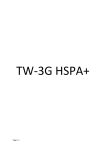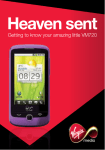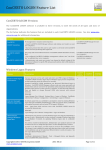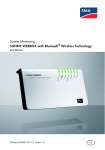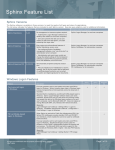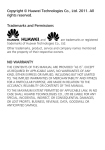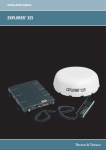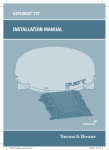Download web`n`walk Stick
Transcript
web'n'walk Stick User Manual Table of contents. MS Windows .........................................................................................3 Launch the web'n'walk Manager ..................................................................................................................................... 4 Interface Overview ............................................................................................................................................................. 4 Status Information .............................................................................................................................................................. 5 Accessing the internet ...................................................................................................................................................... 6 Statistic Information ........................................................................................................................................................... 7 Creating and Sending a Message .................................................................................................................................. 8 Inbox .................................................................................................................................................................................... 9 Outbox ............................................................................................................................................................................... 10 Important, Draft, Trash and Report ............................................................................................................................... 10 Viewing a Message in the SIM Card ............................................................................................................................. 10 Text Settings ...................................................................................................................................................................... 11 Phonebook Management in Local ................................................................................................................................ 12 Phonebook Management in the SIM Card .................................................................................................................. 15 Import/Export ................................................................................................................................................................... 15 Switching a Language .................................................................................................................................................... 17 PIN Operations ................................................................................................................................................................. 17 Choosing a Device .......................................................................................................................................................... 18 Viewing Diagnostic Information .................................................................................................................................... 18 Startup Settings ............................................................................................................................................................... 19 Network Settings .............................................................................................................................................................. 19 Profile Management ........................................................................................................................................................ 20 MacOS ................................................................................................ 23 Launching the Management Program ......................................................................................................................... 24 Setting Profile Parameters .............................................................................................................................................. 25 Managing the PIN ............................................................................................................................................................ 27 Setting the Searching Function ..................................................................................................................................... 27 Contact us .......................................................................................... 28 2 MS Windows. 3 Descriptions of the web'n'walk Manager. To launch the web'n'walk Manager, double-click the shortcut icon of the web'n'walk Manager on the desktop. If you are required to enter the Personal Identification Number (PIN) code, enter the correct one and click If you fail to enter the correct PIN or PIN Unblocking Key (PUK) code, the network-related functions are unavailable. Contact T-Mobile for whether a Subscriber Identity Module (SIM) card is needed. The following table lists the shortcut icons provided by the web'n'walk Manager. Click... To... Connect to the network Query the statistics of the transferred data Display the Text interface Display the Phonebook interface 4 . Status Information. The following table lists all the possible status information. Status information Description Network signal Indicate the signal strength of the network by the following icons: Network information Display the profile of the current network New message If the Text prompt is enabled, when there is a new message: † In the status bar, the icon flashes. † On the lower right corner of the PC screen, the Prompt dialog box is displayed. Unread message When there is an unread message: † In the status bar, the icon flashes. † When you move the cursor to the icon, the number of the unread message(s) is displayed. Network connection The information of the network connection: † : The network is connected. † : The network is disconnected. Transferred data † † : The network is connected. : The network is disconnected. 5 Internet Services. After setting the network and connection profiles, you can access the internet through the web'n'walk Manager. You can connect to the internet by the following option: 1. Click 2. Click (this will become a Disconnect button once you are Connected). to open the web browser and start using the Internet! When the connection is established, the main interface displays the details of the current network, including connected duration, data statistics, transferred rate and so on. When the connection is established, click to disconnect from the network. 6 Statistic Information. You can use the Statistics function to check the traffic of the network. Viewing the Statistic Information. You can do as follows to view the statistic information: 1. Click . 2. In the navigation tree, click the following tabs to display the corresponding diagram. † Transfer: View the uploaded/downloaded speed and data of the current connection. † Statistics: View the current connected duration, last reset time, and daily/monthly/yearly uploaded and downloaded data. Note: The statistical data of the traffic is only for your reference. The actual traffic information is accounted on the basis of the traffic data collected by T-Mobile. Resetting the Statistic Information. You can operate as follows to reset the statistic information: 1. In the navigation tree, right-click a tab. 2. Choose Reset Statistics. 3. In the Confirm dialog box, click Yes. 7 Text Message Services (SMS). The web'n'walk Manager provides Text Message Services (SMS). The local mailbox can store the messages without capacity limitation and can be easily managed. Creating and Sending a Message. 1. Click to display the Text interface. 2. Click to display the New interface. 3. Enter the recipient number by one of the following options: -Click Send To.... Then select a phone number in the Select Number interface. -Enter the recipient number directly. 4. Enter the message content. 5. After the edit, you can choose the following options: -Click Send: To send the message. -Click Save: To save the message in the draft. -Click Close: To exit from editing the current message. If you click Yes in the Confirm dialog box, the message can be saved in the Draft. 8 Note: † You can group send a message to up to 20 phone numbers. Each number should be separated by “;”. † A message can contain 2,048 English letters at most. † Each message can contain 160 English letters at most. If the message content exceeds the maximum size, the system automatically split it into several messages to send. Inbox. Inbox stores the received messages. To display the Inbox interface, do as follows: 1. Click to display the Text interface. 2. Choose Local > Inbox to display the Inbox interface. Searching a Message. Click . Then enter the name/phone number of the message sender, part of the message content or received time. Note: † You can enter part of the message content to search. † When you search the message, a list of the matched messages is updated automatically according to your entered information. The matched contacts in the searched group are displayed. None is displayed when no matched message can be found. Viewing a Message. You can view a message in the inbox as follows: 1. Select a message to read. 2. Click the selected message. The name and phone number of the message sender, message content and receiving time are displayed below the message list. 3. Right-click the selected message for the following options: † Edit: Re-edit the message. † Reply: In the Edit interface, re-edit the message and send it to the message sender. † Forward: Forward the message to another person. † Save Number: In the New Contact interface, enter other information and save the contact. † Delete: Delete the message. † Delete All: Delete All the messages in the inbox. Note: † You can press and hold Shift or Ctrl, and click the selected messages; or you can press Ctrl + A to select all the messages in the list. † The messages deleted from the inbox are stored in the trash. † You can forward only one message a time. You can also click the shortcut icons above the message list to perform the following operations: † : Reply the selected message. † : Forward the selected message. † : Delete the selected message. 9 Outbox. Outbox stores the sent messages, including the messages sent both successfully and unsuccessfully. To display the Outbox interface, do as follows: 1. Click to display the Text interface. 2. Choose Local > Outbox to display the Outbox interface. Note: For details, refer to „Inbox“. Important, Draft, Trash and Report. Important stores your important messages. Draft stores the drafts of messages. Trash stores the messages deleted from the local mailbox. Report stores the delivery notifications after sending messages. Note: † For details, refer to „Inbox“. † The trash does not store the messages deleted from the SIM card. † If you delete the messages in the trash, the messages will be deleted permanently. Be cautious with your operation. Viewing a Message in the SIM Card. If a SIM card is used in your terminal, you can save the sent and received messages in the SIM card. The operations to the messages in the SIM card are as same as those to the messages in the local message box. For details, refer to „Inbox“. Note: Contact T-Mobile for whether a SIM card is needed. 10 You can move a message from the SIM card to the local inbox or local outbox. 1. Click to display the Text interface. 2. Click the SIM tab. 3. Select one or more contacts in the contact list and right-click. 4. Right-click the selected message(s) for the following options: † Move to Local: Move the selected messages from the SIM card to Local. † Move All to Local: Move all the messages from the SIM card to Local. 5. In the Confirm dialog box, click OK. Note: † When the messages in the SIM card are moved to Local, the messages are deleted from the SIM card. † The received messages in the SIM card are moved to the local inbox, and the sent messages in the SIM card are moved to the local outbox. Text Settings. Choose Tools > Options, and click the Text folder. Text handling Settings. In the Text message prompt area, you can select the visual prompt and audio prompt. Option Description Show a notification when a new message arrives When there is a new SMS message, a dialog box is displayed. Then you can: † Click View to view the new message. † Click Close to view the message later. Play a sound when a new message arrives You can perform the following operations: † Click Browse to select a text message tone file. † Click Test to play the text message tone; click Stop to stop playing the text message tone. Note: The text message tone must be a *.wav or *.mid file. 11 Setting the Message Centre Number and Message Validity. The information of message centre number is provided with the SIM card. When the SIM card is inserted, the information is changed automatically. If the information is null or you delete the information by accident, contact T-Mobile. The message validity is the period for storing messages in the Text centre, including such options as 12 Hours, 24 Hours, 30 Days and Maximum. Requesting a Delivery Report. You can select Request delivery report to enable the delivery report function. When the function is enabled, the network can deliver a status report of the sent message. Phonebook. You can manage contacts in the phonebook conveniently by the web'n'walk Manager. Phonebook Management in Local. You can do as follows to enter the local phonebook: 12 1. Click to display the Phonebook interface. 2. Click Local in the navigation tree. Creating a Contact. 1. Click to display the New Contact interface. 2. Enter the information. 3. Click OK to save the contact. Note: The contact information cannot be null or contain spaces or new-line characters only. Searching a Contact. Click . Then enter the contact information. Note: † You can enter part of the contact information to search. Each field of the contact can be supported. † When you search the contact, the contact list is updated automatically according to your entered information. The matched contacts in the searched group are displayed. None is displayed when no matched contact can be searched in the group. Viewing a Contact. You can view a contact as follows: 1. Enter the local phonebook, select a contact to view. 2. Click the selected contact. The contact name, mobile number, office number, home number, E-mail address and remarks are displayed below the contact list. 3. Right-click the selected contact, and you can do as follows: † Edit Contact: Change the information of the contact. † Delete Contact: Delete the contact. † Send: Send a message or name card to the mobile number of the contact. You can also click the shortcut icons above the contact list to perform the following operations: † : Edit the selected contact. † : Delete the selected contact. † : Send a message or name card to the mobile number of the contact. 13 Group Management. You can create a group to manage the local contacts by category. Creating a Group. You can create a group to manage local contacts by category. 1. Right-click Local in the navigation tree, and choose New Group. 2. Enter the group name. Note: † The group name cannot be null or identical to any existing one. † You can manage only local contacts by group. Modifying a Group Name. 1. Select a group to modify. 2. Right-click the selected group in the navigation tree, and choose Rename Group. 3. Enter the new group name. Note: You cannot rename the two default groups, Local and SIM card. Adding a Contact. You can add a contact from Local to another group as follows: 1. Select one or more contacts in Local. 2. Drag the selected contacts to another group. Note: When you drag the selected contact(s), if you press and hold Ctrl, the contact(s) can be copied to another group; otherwise, the contact(s) are moved to another group. You can add a contact to a group as follows: 1. Select a group in the navigation tree. 2. Click ; or right-click in the contact list and choose New Contact. 3. Enter the information. 14 Removing a Contact. 1. Display the contact list of a group. 2. Select a contact to remove. 3. Right-click the selected contact and choose Remove from group. Note: The contact is removed from the group but not deleted. Deleting a Group. 1. Right-click a group in the navigation tree and choose Delete Group. 2. Click OK. Note: When you delete a group, contacts in the group cannot be deleted. They are still in the phonebook of Local or in other groups. Phonebook Management in the SIM Card. You can save the contacts in the SIM card. The operations on the contacts in the SIM card are similar to those on the contacts in Local. For details, refer to „Phonebook Management in Local“. Note: Contact T-Mobile for whether a SIM card is needed. Import/Export. You can export the contacts from Local or the SIM card to a *.csv file, and import the contacts from a *.csv file to phonebook in Local or the SIM card. Note: In the local phonebook, select one or more contacts. Drag the contact(s) to the SIM card in the navigation tree. Then the contact(s) are exported to the phonebook of the SIM card. 15 Importing Contacts. You can import the contacts from a *.csv file to the local phonebook or the SIM card. 1. Click to display the Phonebook interface. 2. Click Local or SIM in the navigation tree. 3. Right-click the contact list and choose Import. 4. Choose a file to import. Click Open to display the Field Mapping interface. 5. Drag the value in the file to the corresponding field on the right respectively. 6. Click OK. Note: † The maximum number of contacts that can be saved in the SIM card is subject to the capacity of the SIM card. † When you import contacts to the SIM card, if its capacity is full, the import stops automatically. The content of the imported contacts is not affected. Exporting Contacts. You can export contacts from the local phonebook and the SIM card. The exported contacts can only be saved in a *.csv file. 1. Click to display the Phonebook interface. 2. Click Local or SIM in the navigation tree. 3. Choose one of the following operations: † Choose one or more contacts and right-click to choose Export Selected Contacts. † Right-click the contact list and choose Export All Contacts. 4. Choose the path to save the contact(s). 5. Enter the file name and click Save. Note: You can press and hold Shift or Ctrl, and click the selected contacts; or you can press Ctrl + A to select all the contacts in the list. 16 Settings and Information Query. Switching a Language. The web'n'walk Manager provides several interface languages for you. During the running of the software, you can choose Tools > Language to switch the languages. PIN Operations. If a SIM card is used in your terminal, the Personal Identity Number (PIN) code protects your card from unauthorized use. You can modify the PIN code and enable/disable the PIN verification. Note: The PIN code and PIN Unblocking Key (PUK) code are provided along with your SIM card. For details, contact T-Mobile. Enabling/Disabling the PIN Verification. You can enable the PIN verification. If it is enabled, you need to verify the PIN code when launching the web'n'walk Manager again. † To enable: Choose Tools > PIN Operations > Enable PIN Verification. † To disable: Choose Tools > PIN Operations > Disable PIN Verification. Modifying the PIN Code. 1. Choose Tools > PIN Operations > Modify PIN. 2. In the Modify PIN dialog box, enter the current PIN code and the new PIN code. 3. Enter the new PIN code again. 4. Click OK to complete the modification. Note: The PIN code should be a numeric string of 4–8 digits. 17 Entering the PIN Code. When the PIN verification is enabled, you need to enter the correct PIN code to use the network-related functions. 1. After the web'n'walk Manager is launched, the Enter PIN dialog box is prompted. 2. Enter the correct PIN code. 3. Click OK to complete the verification. Note: † If you enter wrong PIN codes for a preset number of times, the SIM card is locked and you cannot use it until you enter the PUK code. The web'n'walk Manager prompts you the remaining number of attempts for entering the PIN code or the PUK code. Unlocking the PIN. 1. When the SIM card is locked, the Unlock PIN dialog box is displayed after you start the web'n'walk Manager. 2. Enter the correct PUK code. 3. Enter the new PIN code. 4. Click OK to complete the modification. Choosing a Device. The web'n'walk Manager can support different terminal products. When the web'n'walk Manager is launched, it searches the matched terminal automatically. If two or more terminals are found, the connected terminals are displayed on the Choose Device interface. You can choose a terminal to run and click OK. If two or more supported terminals are connected with the PC, you can change or choose a device during the running of the web'n'walk Manager. 1. Choose Tools > Choose Device. 2. Select a device in the device list. 3. Click OK to terminate the current terminal and switch to the selected one. Viewing Diagnostic Information. Choose Tools > Diagnostics to view the information of the web'n'walk Manager and SIM card, such as the number of messages and contacts saved in the SIM card, firmware version, hardware version, and IMSI number. Note: † The number of messages/contacts in the SIM card is displayed as XX/YY. XX means the number of messages/contacts and YY means the capacity of the SIM card. † The diagnostic information is subject to the terminal that is used. 18 Startup Settings. You can set the web'n'walk Manager to launch automatically along with Windows and minimize the interface after the startup. 1. Choose Tools > Options. 2. Click General in the navigation tree. 3. You can choose the following options: † Select Launch on Windows startup: The web'n'walk Manager launches automatically along with Windows. † Select Minimize window on startup: The interface of the web'n'walk Manager is automatically minimized after the web'n'walk Manager is launched. 4. Click OK to complete the settings. Network Settings. To display the Network interface, you can do as follows: 1. Choose Tools > Options. 2. In the navigation tree, click Network. Selecting a Network Type. You can select different network types to quickly search and access the network. 1. Click the Network Type tab. 2. In the Network Type drop-down combo box, select the corresponding network type. 3. In the Band down-drop list box, select the corresponding frequency band. 4. Click Apply. 5. Click OK to save and enable the settings. Selecting a Registration Mode. You can set the searching and registration mode after selecting the network type. 1. Click the Registration Mode tab. 2. Select Auto search and register or Manual search and register. Auto Search and Register. When you select Auto search and register, the web'n'walk Stick can automatically search and register to a supplied network. 19 Manual Search and Register. 1. Select Manual search and register. 2. Click Refresh. 3. Select an operator name in the list. 4. Click Register. Profile Management. You can display the Dial-Up interface by one of the following options: 1. Choose Tools > Options. 2. In the navigation tree, click Profile Management. 3. Click the Dial-Up tab. Note: † If the current network type is the HSDPA/UMTS network, click the Dial-Up tab. † For details about setting the profile, contact T-Mobile. Creating a Dial-up Profile. 1. Click New to set the profile name, access number, user name, password, Access Point Name (APN) and APN status, and select a default device. 2. Click Advanced to set the IP information, authentication protocol, Domain Name Server (DNS) and Windows Internet Name Service (WINS). 3. Click OK to save the advanced settings and return to the Dial-Up interface. 4. Click OK and the Prompt dialog box is displayed. 5. Click Yes to save the settings; or click No to cancel the settings. Editing a Dial-up Profile. 1. In the Profile Name drop-down combo box, select a setting. 2. Click Edit to modify the profile name, access number, user name, password, APN name and APN status, and select a default device. 3. Click Advanced to set the IP information, authentication protocol, DNS and WINS. 4. Click OK to save the advanced settings and return to the Dial-Up interface. 5. Click OK and the Prompt dialog box is displayed. 6. Click Yes to save the settings; or click No to cancel the edits. 20 Deleting a Dial-up Profile. 1. In the Profile Name drop-down combo box, select a setting. 2. Click Delete and the Prompt dialog box is displayed. 3. Click Yes to delete the setting; or click No to cancel the deletion. Importing a Dial-up Profile. 1. Click Import and the Import interface is displayed. 2. You can choose the following options: † Select the 3G/GPRS network operator(s) in the list. † Click Browse and choose a *. prof file to import. Then click Open. 3. In the Import interface, click OK. Exporting a Dial-up Profile. 1. Click Export and the Export interface is displayed. 2. Select one or more network operators and click OK. 3. Select the path to save the file and enter the file name. Then click Save. Note: The dial-up profile of the selected operator is exported to a *. prof file (a configuration file). 21 FAQs. What shall I do if I cannot access the Internet? 1. Check the network signal strength. 2. Check whether you have activated the wireless online service. You can ask the local network operator on how to activate it. 3. If the wireless online service is activated, check network settings according to the instructions in „Internet Services“. Why only part of the pasted content can be displayed during the edit? When editing a message, at most 2,048 English characters can be entered. If the quantity of the pasted information exceeds the limit, the exceeding part will be deleted automatically. When a message is received, no prompt is displayed. Why? You have not set the vision alert of messages. Choose Tools > Options > Text. In the Text handing area, select Show a notification when a new text arrives. Why the phone number cannot be pasted? A valid phone number can only contain „0123456789#*+“. Confirm that no other character is in the cut or copied Text. 22 MacOS. 23 Parameter Settings. When the management program is installed successfully, you can launch the program and set the parameters. The following sections describe the detailed procedure. Note: † The figures in the manual are just for your reference only. † When you are roaming the other network, the management program display: you are now in roaming state!. Launching the Management Program. 1. Insert the SIM card into the web'n'walk Stick. 2. Connect the data card to your MacBook. 3. Open the Finder window, and select Mobile Connect in the Application directory. Then launch the management program of the Mobile Connect. If the Personal Identification Number (PIN) code of the data card is locked, the system displays the Verify PIN dialog box for you to enter the PIN code. 4. If you enter wrong PINs for three consecutive times, the system displays the PIN Unblocking Key dialog box for you to enter the valid PIN Unblocking Key (PUK). Then the Mobile Connect interface is displayed, as follow. Note: † If you enter wrong PUKs for ten consecutive times, the SIM card is invalid permanently. † The PIN and PUK are delivered with the SIM card provided by T-Mobile. For details, consult T-Mobile. 24 Setting Profile Parameters. Select Profile Name and click Connect for the dial-up access. When you access the internet successfully, the system displays the prompt, saying „Success to Connect“. The operation about adding profile name as follows: 1. In the main interface of the management program, click Setting. Then the interface for setting parameters is displayed. 2. Click New to set the profile parameters. 25 Note: † You can select a profile name in the Profile Name drop-down list. When there is no desired profile name in the list, you need to create one. † The profile name is decided by your own. The values for Access Point Name, Telephone Number, Account Name and Password are obtained from the service provider. † By default, the value of Telephone Number is set to *99#. 3. Click Save to save the settings. 4. Click OK to return to the Mobile Connect interface. 26 Managing the PIN. 1. On the menu bar of the management program main interface, choose Manage PIN > Active to activate the PIN protection. Choose Manage PIN > Deactive to deactivate the PIN protection. 2. Choose Manage PIN > Modify to modify the PIN code. Note: † You should enter the correct digits in the Current PIN code text box. † The values entered in the New PIN Code and the Confirm text box should keep consistent. Setting the Searching Function. 1. On the menu bar of the management program main interface, choose Select Network > Manual. 2. In the Profile Name list, select a profile name to be searched. 3. Click Register to search the network. Note: By default, the management program uses the function of searching the network automatically. 27 Contact us For technical help including FAQ’s, troubleshooting and downloads go to www.t-mobile.co.uk/datacardhelp. If you can’t find what you’re looking for on the website, then call us on 0845 412 2993 (charged at local rate). If you have a more general enquiry then please call 150 free from your mobile or 0845 412 5000 (charged at local rate). T-Mobile Customer Services is open from 7am to 10pm everyday.































